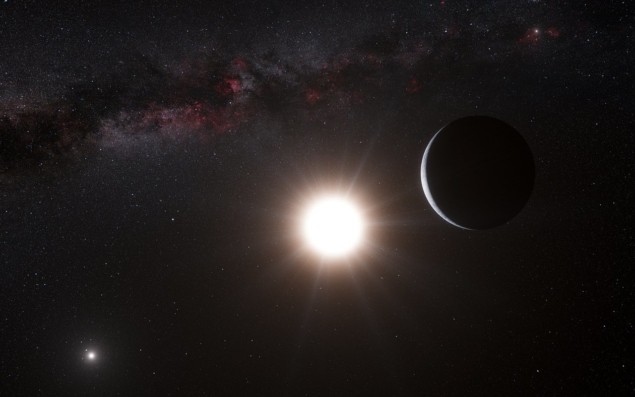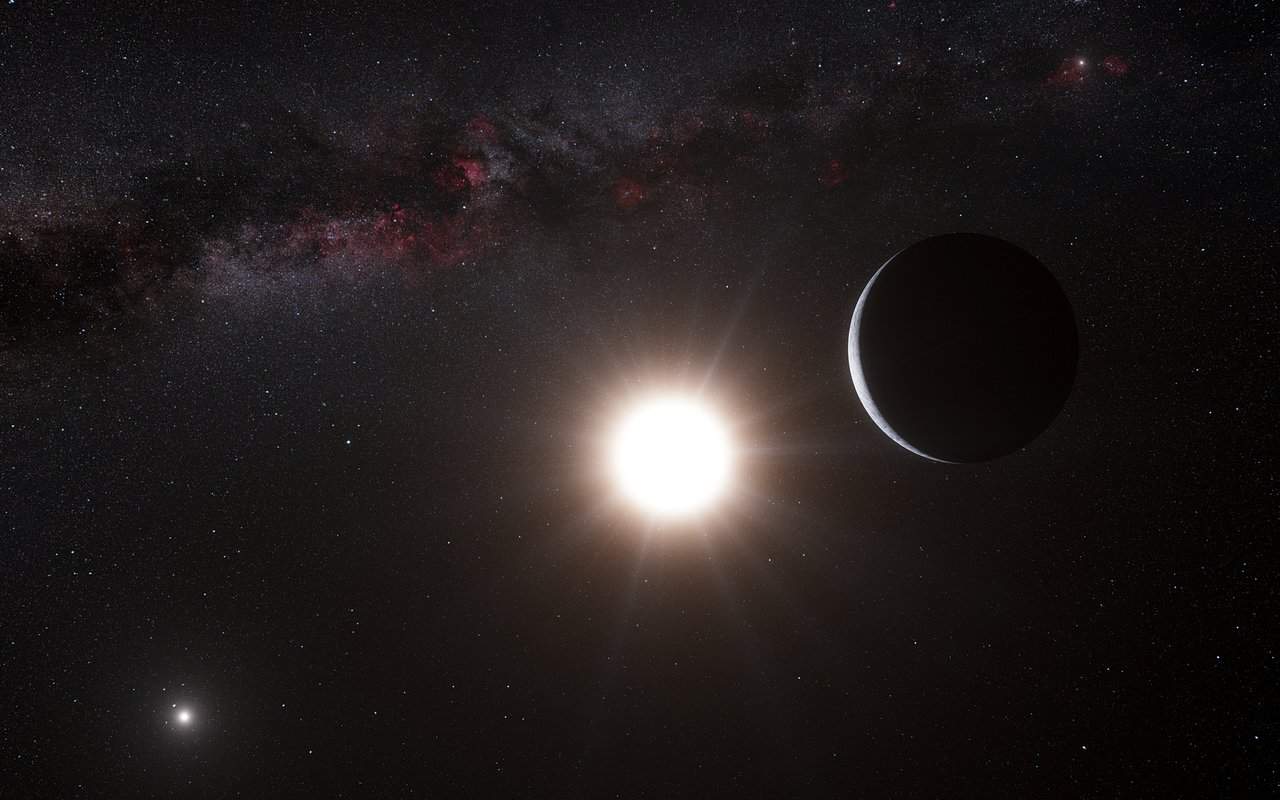
Planets orbiting the Sun-like stars of Alpha Centauri could be carbon-rich worlds with diamonds and graphite littered across their surfaces, say astronomers. Although the existence of such planets has not been confirmed, the team argue that modelling their hypothetical mineralogy, interior structure and atmosphere could guide future observations by shaping our understanding of what is possible.
Alpha Centauri is a multiple-star system just 4.3 light years away that features two Sun-like stars, designated A and B, plus the red dwarf Proxima Centauri. So far, astronomers have discovered one confirmed exoplanet (and two strong candidates) orbiting Proxima, but a 2012 “discovery” of a planet orbiting Centauri B was later disproven. A candidate planet for Centauri A is currently awaiting confirmation after its discovery in 2021.
Despite the lack of confirmed planets around Alpha Centauri A or B, a team led by Haiyang Wang of ETH Zürich, Switzerland and the Swiss National Center for Competence in Research PlanetS set themselves the challenge of modelling what any planets orbiting the two stars might be like. “The model is the first of its kind and has proven to be useful for estimating the bulk elemental compositions of habitable-zone terrestrial planets orbiting Sun-like stars,” Wang tells Physics World.
Carbon world
Developed in 2019 by Wang and colleagues including Charley Lineweaver of the Australian National University, the new model allows astronomers to predict the chemical composition and mineralogy – and consequently the geology and atmospheric gases – of a planet. The “devolitization model”, as it is known, produces estimates for the abundance of volatile gases, such as water, carbon dioxide and nitrogen, that are driven out of planet-forming material by the heat from a nearby proto-star.
Within our Solar System, for example, the carbon-to-oxygen (C/O) ratio is 0.5, meaning that there are twice as many oxygen atoms for every atom of carbon. Much of the carbon therefore ends up bonded to oxygen. A large amount of the remaining oxygen, meanwhile, bonds with elements such as silicon and iron to form rocks.
When Wang and colleagues applied the devolitization model to Alpha Centauri A and B, the C/O ratio came out higher, at 0.65. Any planets in this system would therefore be enriched with more carbon-bearing minerals, although how much carbon would exist on their surfaces remains unclear. Previous studies of carbon-rich planets have invoked a C/O ratio of 0.8, and at this level, the team’s chemical modelling indicates that “a large amount of carbon would be left over to form carbides, graphite and – with lots of pressure in the interior – diamonds,” Lineweaver says.
For a ratio of 0.65, however, the amount of surface carbon is less certain. “Any extra carbon may sink into the planet’s core,” Wang notes. To answer the question more fully, astronomers would need to conduct a spectroscopic analysis of the Alpha Centauri system at a precision more than twice the level of current instruments.
Stagnant planets
Too much carbon could be bad news for the habitability of any Alpha Centauri planets, Wang says. “Such a planet would be more geologically dead due to diamond’s increased thermal conductivity and viscosity,” she explains. A planetary mantle that conducts heat rather than undergoing convection would transfer heat from the planet’s core to the surface more slowly, allowing the crust to solidify. When coupled with a measured 25% reduction in heat-producing radioisotopes compared to our Solar System, this could lead to planets with so-called “stagnant lids”, where a lack of convection in the mantle produces a solid crust and no plate tectonics.
The absence of active volcanoes belching carbon dioxide into the atmosphere would, in turn, severely reduce the planet’s active carbon cycle. This cycle acts as the planet’s long-term thermostat, removing carbon dioxide – a greenhouse gas – from the atmosphere before it overheats and putting it back in to prevent the planet freezing over for too long. Without an active carbon cycle, carbon-rich planets around Alpha Centauri A or B could suffer from a Venus-style runaway greenhouse effect or completely freeze over, depending upon their distance from their star.
“It’s my personal take, [but] the chance of finding an Earth-like planet around Alpha Centauri A or B is less than that of finding an analogue of either Venus or Mars,” Wang says. The model predicts that a hypothetical Alpha Centauri planet would begin life with an atmosphere composed of carbon dioxide, methane and water – similar to Earth’s atmosphere between 4 and 2.5 billion years ago – before evolving to become dry and dominated by carbon dioxide.
Real-life planetary laboratories
Given that no exoplanets have been confirmed around Alpha Centauri A or B, Debra Fischer, of Yale University, US, is cautious about the new results, which appear in The Astrophysical Journal. “Theory leading observations has never worked out well in the field of exoplanets,” says Fischer, who was not involved in the study. “This may be one evolutionary path for putative planets that have not even been detected yet.”

‘Exoplanet’ discovery vanishes in a puff of dust
Meanwhile, Nikku Madhusudhan of the University of Cambridge, UK, points out that large uncertainties in the C/O ratio of the Alpha Centauri system make it consistent with a Sun-like composition as well as the higher-carbon version discussed in the ETH study. However, he adds that “the results are interesting, nevertheless”.
Lineweaver agrees that some of the model’s conclusions should be treated with caution. “I am less confident [than Wang] in the connection between our modelling and predicting the convective status of the rocky planets in the Alpha Centauri system,” he says. However, on the question of exoplanets existing in the Alpha Centauri system, Lineweaver says he is “more confident than most astronomers” despite questions about how frequently planets form in the dynamic gravitational fields of a binary star system. If the candidate world spotted in 2021 proves to be real, Lineweaver, Wang and their team may yet have a real-life laboratory for testing their models.
